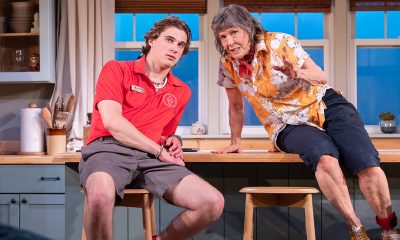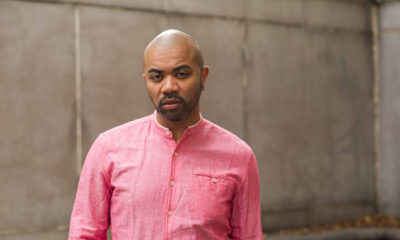Living
Plan now for summer camps
Local schools, centers welcome LGBT families for season’s activities

Summer may still be a few months away, but many area camps are already filling up. Here are a few LGBT-welcoming places to check out.
Adventure Theatre (7300 MacArthur Blvd., Glen Echo) has a summer camp for children ages 6 to 15. There are six sessions, including a mini session at the beginning of the summer. The mini session lasts a week, while the regular sessions last two weeks, Monday through Friday from 9 a.m. to 4 p.m.
The sessions end in four full-scale productions with costumes and props on the theater’s main stage.
The mini session is $400 plus a $14 registration fee and the two-week sessions are $800 plus the registration fee. There is also before and after care available at an addition price.
For more information and to begin registration, visit adventuretheatre.org.
Silver Stars Gymnastics has two locations in the area in Silver Spring (2701 Pittman Drive) and Bowie (14201 Woodcliff Court) with summer camp programs for children ages 3 and a half to 15.
Silver Stars gives kids the opportunity to learn cartwheels, navigate the monkey bars and climb the ropes. There are also nine different trampolines for children to safely learn to jump, tuck, twist and flip.
Full days run from 8:30 a.m. to 4:30 p.m. with half days running from 9 a.m. to noon. Sessions last a week and are $290 for full day and $220 for half day with the exception of the week of July 4, which is $220 full day and $160 full day.
Parents also have the option for extended mornings for an additional $25 a week and extended afternoons for an additional $50 a week.
For more information, visit gosilverstars.com.
CommuniKids Preschool and Children Language Center offers Spanish, French, Mandarin and Arabic Immersion summer camps for children ages 2 and a half to 6.
The D.C. location (4719 Wisconsin Ave., N.W.) offers a Spanish immersion camp for children ages 2 and a half to 6. The Falls Church location (510 N. Washington St.) offers Spanish and French for children ages 2 and a half to 6 and Arabic and Mandarin Chinese for children ages 3 to 6. Both locations offer morning and afternoon extended care.
Each session, starting July 16, runs a week, with half-day and full-day options. A full-day session, running from 9 a.m. to 3 p.m., ranges from $375 to $400 and a half-day session, running from 9 a.m. to 12:30 p.m., is $250.00. Before care, starting at 8 a.m. is an additional $20 per session while after care, ending at 6 p.m., is an additional $50 per session.
For more information and to see multi-session discounts, visit communikids.com.
Georgetown Day School offers many different camps, including an option to design your own camp.
For children in pre-school up to fifth grade, there is a day camp that runs from June 18 to Aug. 17. There are also sports camps, including soccer from July 2 to 13, a multi-sports camp from July 16 to 27 and basketball camp from July 30 to Aug. 3. There’s a math camp from June 18 to 29, various music programs running throughout the summer and a typing program. Camps range from $165 to $395 a week with varying times.
Teens rising to sixth grade up to 12th grade have their own programs. There’s a dance camp from June 18 to 29 for different levels, theater camps focusing on acting, the technical side and playwriting from July 27 to Aug. 10, music camps throughout the summer, film and animation from Aug. 20 to 24 and a service learning camp.
For more information and to register, visit gds.org. Camp locations and prices vary based on program.
The YMCA in D.C. offers a variety of camps for kids of all ages.
There’s Camp Sampler, which allows campers to experience programs from other camps, Cooking Delight, where campers learn the basics of cooking and nutrition and Medieval Madness where campers learn about the Middles ages by building castles, moats and playing games.
There are also specialty camps such as Active Arcade where campers play interactive video games like Wii Sports and Dance Dance Revolution, Creative Writing for those future novelists and Harry Potter Wizardy where campers can practice Quidditch, get sorted into a house and more.
The YMCA also offers sports camps, dance camps, art camps and more.
Prices vary based on program and membership with the YMCA. For more information, visit ymcadc.org.
The Lowell School (1640 Kalmia Rd., N.W.) has camps for children ages 3 to 14 beginning June 18.
The summer program is divided into two three-week sessions where campers will be able to participate in several activities each day. Campers in third grade through sixth grade will choose two interest areas in the morning and will spend three weeks focusing on more specialized skills that pertain to that activity.
After a lunch and some free time, campers spend the afternoon by choosing from the “jamboree,” a selection of activities that dance daily. The afternoon activities could include playing kickball, baking brownies or learning to jump double dutch. Campers will also have access to the indoor pool.
There is an application fee of $65 per camper plus a $150 tuition deposit. Each three-week session ranges from $730 to $1,465. There additional charges for after care and other options.
The Green Acres School (11701 Danville Drive, Rockville) has three different camp programs.
The Kreative Kangaroo program is one six-week session from June 18 to July 27. Younger children are introduced to summer camp with a mix of indoor and outdoor activities including science, arts and crafts, swimming and more. These campers must be 4 by Sept. 1.
The Junior Camp Program is one six-week session, also from June 18 to July 27, divided into four units, Unit D acting as a bridge between Junior Camp and Senior Camp. In this program, campers can pursue a special interest and even develop a new one. Activities are chosen on a daily basis. Each unit has a Special Day, when the activities revolve around a particular theme and Units B and C stay late on campus.
The Senior Camp Program is two sessions, June 18 to July 6 and July 9 to July 27. This program is for campers entering fourth to seventh grade. They design their own schedules based on their interests. At least 10 different activities are offered for each of the afternoon workshop periods. They change daily and are chosen the day before. This program also includes day trips and overnights, including a weekly field trip for campers in Units G and H.
Tuition is $2,370 for the six-week sessions, $1,325 for the first senior camp session and $1,500 for the second senior camp session. There is also a $60 application fee, $225 tuition deposit and various other camp fees.
For more information, visit greenacres.org.

Electric-vehicle tax credits may have faded earlier this year, but EVs themselves are far from losing their spark. There are more charging stations than ever, battery ranges are longer and more realistic, and automakers have finally figured out that EVs don’t all need to look like geeky science projects or feel like failed beta tests.
Just look at these two compact electrics, which are futuristic, fun and flexible enough for work or play.
HYUNDAI IONIQ 5
$37,000 to $48,000
Range: 245 to 318 miles
0 to 60 mph: 4.5 to 7.4 seconds
Cargo space: 26.3 cu. ft.
PROS: Fast charging. Roomy cabin. Silky-smooth suspension.
CONS: Wide turning radius. Rear wiper not on all trims. Price creep.
After being introduced three years ago, what’s new for the latest Hyundai Ioniq 5? Mostly refinement. Charging is quicker, software is smarter and Hyundai continues to quietly listen to feedback, tweaking ride comfort and usability. Think of it as switching from messy eyeliner to a perfectly sharp wing.
Exterior styling remains one of this EV’s biggest conversation starters. Those pixel-inspired lights, crisp lines and slick hatchback-meets-crossover proportions exude refreshing confidence. There’s no trying to blend in, and that’s the point. Park this Hyundai anywhere and heads will turn.
On the road, the Ioniq 5 prioritizes calm over chaos. Steering is light, the suspension smooths out rough pavement and acceleration feels brisk without being aggressive. Safety tech is plentiful and well-calibrated—adaptive cruise control, lane-centering, blind-spot monitoring—all working together without seeming like a nervous backseat driver. IOW, this ride is supportive, not clingy.
Inside, the user-friendly cabin shines. The flat floor and long wheelbase create a lounge-like atmosphere, with excellent legroom and airy visibility. Seats are well-bolstered and available with eco-friendly materials, and the sliding center console adds flexibility. Cargo space is generous, and the wide windshield makes city driving stress-free. Alas, the rear wiper is only available on select models. Overall, though, I appreciated how everything looks modern without feeling cold.
What makes this Hyundai special is its vibe. An EV that embraces individuality without shouting about it.
Fun fact: The Ioniq’s ultra-fast charging can add hundreds of miles in under 20 minutes—perfect for those who hate waiting almost as much as they hate small talk on awkward first dates.
VOLKSWAGEN ID.4
$46,000 to $59,130
Range: 206 to 291 miles
0 to 60 mph: 4.4 to 7.7 seconds
Cargo space: 30.3 cu. ft.
PROS: Sure handling. Decent range. Good storage.
CONS: Body roll in curves. Fussy infotainment. No frunk.
The latest VW ID.4 focuses on polish. Software updates have fixed earlier frustrations, and overall drivability feels more cohesive. Less “learning curve” and more “hop in and go,” like a dependable bestie who doesn’t overthink things.
Styling-wise, this EV is intentionally inoffensive. Soft curves, friendly lighting and a familiar crossover shape make it approachable. While the ID.4 won’t turn heads like the Ioniq 5, that’s OK. It’s more akin to a classic outfit that always works—timeless, not trendy.
Driving the ID.4 is relaxed and predictable. This SUV prioritizes comfort over thrills, with a suspension tuned for daily commuting and long highway drives. Safety features are comprehensive and reassuring, including excellent lane assistance and collision-prevention systems. It’s the kind of car that quietly has your back, no drama required.
Inside, the ID.4 offers a calm, uncluttered cabin with good space for passengers and cargo alike. Rear-seat legroom is especially strong, making it a solid road-trip companion. The seats are plush, visibility is good and while the infotainment system isn’t the most intuitive, it’s improved enough to be more than tolerable.
The ID.4’s special sauce is balance. It doesn’t try to reinvent the wheel—it just electrifies it.
Fun fact: This is one of the most globally popular EVs, proving that sometimes being universally liked is a strength, not a personality flaw. Think, gold star gay who still surprises you.

Real Estate
Child- and pet-proofing your home for the holidays
It isn’t about being perfect but about being prepared

The holidays are meant to be joyful, cozy, and full of laughter — but if you have young children or pets, they can also feel a little chaotic. Twinkling lights, shiny decorations, guests coming and going, and tables full of tempting food can turn your home into a wonderland of curiosity and mischief. The good news? With a little thoughtful planning, you can keep the holiday magic alive while making your home safer for everyone who lives there.
There’s something oddly comforting about movies where animals go to war with holiday decorations, turning carefully strung lights and perfectly placed ornaments into chaos. Whether it’s a mischievous dog tangled in tinsel or a curious cat launching a full-scale assault on a Christmas tree, these scenes tap into a universal experience for pet owners.
The humor comes from the contrast: the human characters are trying to create warmth, tradition, and picture-perfect cheer, while the animals see the decorations as toys, obstacles, or personal enemies. The resulting destruction — trees tipping over, ornaments shattering, lights blinking out—feels exaggerated but relatable, especially during the already hectic holiday season.
Let’s start with decorations because they tend to be the biggest attraction. Ornaments sparkle, garlands dangle, and everything seems designed to be touched, pulled, or tasted. If you have little ones or pets, consider placing your most fragile ornaments higher on the tree and using shatterproof options on the lower branches. Tinsel and ribbon may look festive, but they can be dangerous if swallowed, so skipping them or keeping them well out of reach is a simple way to reduce risk without sacrificing style.
Holiday lights are another favorite fascination. Before hanging them, take a few minutes to inspect each strand for frayed wires or broken bulbs. Secure cords along walls or behind furniture so they’re harder to grab or chew and unplug them when you leave the house or head to bed. Not only does this help prevent accidents, but it also gives you one less thing to worry about during a busy season.
The Christmas tree itself can become a focal point for exploration. Make sure it’s sturdy and well-anchored so it doesn’t tip if a toddler tugs on a branch or a pet decides to investigate. If you use a real tree, cover the water base since tree water can contain additives that aren’t safe if consumed. For artificial trees, keep an eye out for loose pieces or needles that could become choking hazards.
Food is a big part of holiday celebrations, and it’s also one of the most common sources of trouble. Many traditional treats—like chocolate, grapes, raisins, alcohol, and foods containing xylitol—are dangerous for pets. Keep plates and serving dishes up high, secure the trash can, and gently remind guests not to slip pets or kids “just a little bite” without checking first. For children, be mindful of hard candies, nuts, and small treats that could pose choking risks.
Candles and fireplaces add warmth and charm, but they deserve extra caution. Flameless candles are a wonderful alternative if you want ambiance without worry. If you do use real candles, place them well out of reach and never leave them unattended. Fireplaces should always have a sturdy screen or gate, especially with crawling babies or curious pets nearby.
Holiday gatherings bring wonderful energy into your home, but they can also create new challenges. Doors opening frequently make it easier for pets to slip outside, so consider setting up a quiet, comfortable space where they can relax during busy get-togethers. This can help reduce stress for them and give you peace of mind. For children, stair gates, locked cabinets, and clear boundaries can help prevent accidents when there’s extra excitement in the air.
New toys and gifts are another thing to watch closely. Packaging, twist ties, plastic wrap, and especially button batteries should be cleaned up promptly. These items are easy to overlook in the excitement of gift-opening but can be dangerous if swallowed. Taking a few minutes to tidy up as you go can make a big difference.
Lastly, try to keep routines as steady as possible. The holidays naturally disrupt schedules, but familiar mealtimes, naps, walks, and bedtime rituals help children and pets feel secure. A calmer household often means fewer accidents and a happier experience for everyone.
At the end of the day, child- and pet-proofing your home for the holidays isn’t about being perfect but about being prepared. A few small adjustments can help you relax, enjoy your guests, and focus on what truly matters: creating warm, happy memories with the ones you love. When your home feels safe, the holidays feel even sweeter.
Valerie M. Blake is a licensed Associate Broker in D.C., Maryland, and Virginia with RLAH @properties. Call or text her at 202-246-8602, email her at [email protected] or follow her on Facebook at TheRealst8ofAffairs.
Real Estate
In real estate, trust the process
With rates coming down, we could see spring surge in buyers

The average 30-year mortgage rate is falling, little by slowly. With predictions that the rate will continue to adjust downward in the next year or two, there may be a busier spring market than we have seen in the last few year, especially for the DMV market, which has been reeling from thousands of layoffs this past year. The frenzied activity resulting from interest rates close to 3% for some borrowers will probably not occur; however, this spring could add up to be a few notches busier than the last.
What does this mean for buyers and sellers? Lender Tina Del Casale with Waterstone Mortgage says she has seen “low to mid 6’s as the average for conventional loans.” If rates continue downward into the 5% range, there may be more activity than we saw in the last year or two. This could release a little bit of pent up demand.
Many buyers will have found that for whatever reason, their current home is not meeting their needs. Sellers may want to finally take the plunge and put a for sale sign in the yard and online, now that they might find a more reasonable rate on their next home. This winter can be an opportunity to assess financial situations, home conditions, and optimize one’s chances to have a sale with more agreeable terms, or put one’s best foot forward in an offer. In addition to checking with a lender or favorite handy person, let’s review what sellers and buyers typically spend their energy negotiating while enjoying the lovely process called “going under contract”:
- Timelines – Sellers might want to have their house solidly under contract (papers signed, thumbs up from the lenders, all inspection items decided upon and settled) so that they can put an offer down on a new home, and then negotiate that timeline with the other sellers. Remember, making a move is not only about the buyer taking possession of a new home, but also about the sellers figuring out their situation as well.
- Sale Price – unfortunately for buyers, in the eyes of most sellers, “money talks.” So, in a non-competitive situation, a seller might be happy to just get one offer at a price that was within the desired range. As soon as another interested buyer enters the equation, it can become a little bit like RuPaul’s Drag Race, and one will have to lip sync for one’s life, honey! And only one buyer will get to hear the words, “condragulations!”
- Tone/Vibes/Energy in the Room – Remember: Human beings are emotional creatures. All of us have feelings. And all of us want to put energy into situations where we feel appreciated, where a level of self-awareness exists, and a sense that each side is trying one’s hardest to act in good faith. The best transactions I saw were where a little grace was the “grease on the wheels” of the transaction. Occasionally, a buyer had cold feet and wanted to see the unit a few more times before the settlement date, or a seller forgot to scrub the bathroom with a little extra elbow grease before the settlement date. Life happens; misunderstandings can occur. A wise therapist once said: “You don’t have to like it, but can you allow it?” The tone of one or both parties in the transaction can be what seals the deal, or results in one party exiting the contract. (In the case of the dirty bathroom, the seller left a check with the title company for the buyer to pay a housekeeper to come clean what they couldn’t.)
Joseph Hudson is a referral agent with Metro Referrals. He can be reached at 703-587-0597 or [email protected].
-

 District of Columbia1 day ago
District of Columbia1 day agoReasons to be optimistic about 2026
-

 Commentary3 days ago
Commentary3 days agoAmerica is going in the wrong direction for intersex children
-

 District of Columbia3 days ago
District of Columbia3 days agoRush reopens after renewing suspended liquor license
-

 Real Estate4 days ago
Real Estate4 days agoChild- and pet-proofing your home for the holidays



















